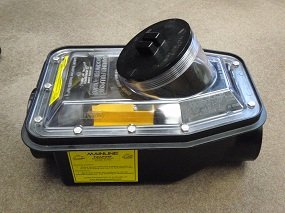Plumbing inside our homes is complicated and convoluted, but that’s only the tip of the iceberg. Once you start looking at how a private residence’s water supply is connected to the public water supply, things start to get very complicated. The movement of water between homes and public supplies must be carefully regulated and controlled for a number of reasons, chief among them being the quality of the water entering homes.

A backflow prevention device before being installed
Water that enters private residences has to meet certain safety and cleanliness standards that are handed down by federal, provincial, and local laws and regulations. Similarly, water that leaves private residences must be contained, treated, and disposed of according to similar regulations from all levels of government. When water flows in the wrong direction, it can become contaminated, which is why devices exist to keep water flowing the right direction, the two most popular being backwater valves and backflow prevention devices. These devices serve similar functions but are used in different ways, which is something that homeowners need to understand when it comes to keeping their homes dry and their water clean.
Backflow Preventers
Backflow prevention devices are largely used to protect the city water supply from the dirty water in private residences. Since most areas of North America have water standards that must be met to the point of delivery (ie. the second it enters your home), the water must be completely safe up until that point. After that, it must be considered contaminated because the jurisdiction over the water quality has shifted from the public water works to the local private residence owner. Testing is an important part of backflow preventers to ensure that they are working as intended, we are licensed to provide backflow preventer testing in Toronto and beyond.

An air gap preventer is another common backflow prevention device
Air Gap Backflow Preventers
The most common kind of backflow prevention device isn’t a device at all, it’s simply a gap. Called an “air gap,” this backflow prevention device is simply a vertical break in the water supply. The water flowing in the right direction drops a short amount of space in the open air before continuing along its journey.
In the event of backflow, however, the water is forced upwards. Since there is no pipe in the air gap to help the water continue to flow upwards, the water instead spreads out and away from the pipe. The mess is localized and the problem is stopped by simple intuition. Other backflow prevention devices exist, but the simplicity, affordability, and reliability of the air gap has made it the most popular choice around the world.
Air gaps and similar backflow prevention devices are designed to protect the public water supply from contaminants in the water supply. But private residences also need to protect their homes from the water flowing back into the water system, namely sewage disposal and dirty water that must exit the home. This is accomplished by something called a backwater valve, which can be easily installed in every home by a trained plumbing professional.
Backwater Valves

A backwater valve is actually a very simple device when compared with backflow prevention devices
Backwater valves, like air gaps, are an ingenious and simple piece of equipment that helps stop dirty water from flowing back into your home. The device is a little more complicated than an air gap, but not by a substantial margin.
Essentially, a backwater valve works like a small door. When water is flowing the right way, it pushes the little door open and the water can freely flow. When the water starts to flow the other way, however, it pushes against the wrong side of the door and it closes up. The end result is the backflow water that wants to get back into your home is stopped before it can do any damage. We have provided Toronto backwater valve installation services for many years and know the ins-and-outs of how to correctly carry out this work.
Essential In Modern Homes
Backwater valves are an essential aspect of modern living, and often required in homes. If you do not have a backwater valve, or it isn’t working properly, you could be in violation of the local plumbing code, which could impact the value of your home. Luckily, programs exist to help offset the cost of a backwater valve. Be sure to check with your municipality to see if they can help.
Backwater valves differ from backflow prevention devices in one key aspect: backwater valves are designed to protect you from the public water system, and backflow preventers are designed to protect the public water system from you. These simple devices are key to keeping our water supplies, both individually and as a whole, cleaner, more efficient, and more reliable. Without these devices, our water systems could not operate.
If you don’t have a backwater valve installed in your home, you are at a great risk for flooding, water contamination and more. Be sure to contact a trained and certified plumbing contractor to get a backwater valve installed in your home today. Without it, you could be in for a nasty surprise from the local sewage lines.







It really got my attention when you said that backflow preventer devices are used to prevent contamination in our water supply. I am planning on having a backflow preventer installed in my home to make sure that our water is clean and free from any contamination. I don’t want my kids suffering from any health hazards, and that is why I want to have this device installed.